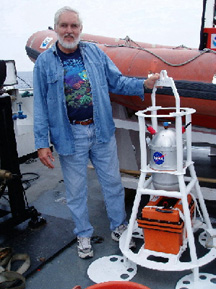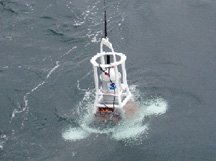May
11, 2004
It's
now 2000 hours and I have been on the Nancy Foster for 29 hours.
The food is great; the science team is wonderful; the work is fun;
and I
am learning a ton about fisheries science.
We
had an incredibly busy day. We decided Monday evening to begin our
sampling in the high recreational use-area of Gray's Reef and try
to get
as much work as possible taken care of before the weekend. This
decision was made in hopes that we can avoid human interference as
much
as possible since we have very sensitive instruments that could possibly
become affected. We deployed several different instruments during
the
course of the day using the J-Frame, as well as six fish traps that
were
simply pushed off the back of the boat. You should have seen everyone
donned in their hard hats, life jackets, and walkie-talkies! What
a
sight!
Two
Passive Acoustic Monitoring Systems (PAMS) instruments were deployed
this morning. PAMS has a hydrophone (a microphone that is used
in
water), a computer, batteries and a structure that holds the equipment
up and off of the ocean floor. He will use PAMS to record sounds
made by fish in order to glean as much as he can about the fisheries
in
Gray's Reef. With one PAMS unit, Dr. Gilmore can listen to fish that
are located miles and miles away from the instrument.
 
Dr.
Grant Gilmore developed the PAMS - Passive Acoustic Monitoring Systems
instrument, used for detecting sound in the marine environment.
There
are several factors that affect how well this instrument detects sounds
emanating from far away. Sound moves five times faster in water than
air because water has a higher density than air does. Additionally,
the range of frequencies that are produced by the animals also affects
how well PAMS will detect the sounds. Most fish all
produce sounds at low frequencies which give the sound a low tone.
The
lower the frequency, the farther the sound will travel. Properties
of
water masses also affect the propagation of sound waves through the
water. If the water is dense, cold, and deep enough, PAMS can pick
up
sounds that originate hundreds, even thousands, of miles away.
 So
how can we use the data that is collected by PAMS in order to gain
a better understanding about fisheries and Gray's Reef? One such application
of the sounds captured with PAMS is the possibility to determine whether
spawning is occurring or not. There is a direct relationship between
the loudness of sounds emitted and the spawning cycles of fish in
our general area. Many female fish along the southeast coastal areas
do not produce sounds, with the exception of the female black drum.
It is up to the male fish to attract females with their strong, deep
sounds. In fact, the male spotted sea trout has as many as three different
sounds that he uses to attract a mate! So
how can we use the data that is collected by PAMS in order to gain
a better understanding about fisheries and Gray's Reef? One such application
of the sounds captured with PAMS is the possibility to determine whether
spawning is occurring or not. There is a direct relationship between
the loudness of sounds emitted and the spawning cycles of fish in
our general area. Many female fish along the southeast coastal areas
do not produce sounds, with the exception of the female black drum.
It is up to the male fish to attract females with their strong, deep
sounds. In fact, the male spotted sea trout has as many as three different
sounds that he uses to attract a mate!
Grant
is interested in collecting human-related sounds, as well as fish
ones. Sounds associated with boating or fishing are the kinds of human
sounds that PAMS frequently records. Why is he concerned with human
sounds if his research focuses upon fisheries, you are probably asking?
Each boat has a different sound due to the different kinds of motor
and
the shape of the boat's hull. If he can capture enough recordings
of
human activity with PAMS, he will be able to decipher fish sounds
from
human ones and this will help him monitor the system as a whole. As
you
can see, there seems to be a lot we can learn about fish by just
listening to them, especially when using something as technologically
advanced as PAMS.
For
more information on PAMS, CLICK
HERE to visit the Oculina Coral Banks 2003 expedition daily log.
|





 So
how can we use the data that is collected by PAMS in order to gain
a better understanding about fisheries and Gray's Reef? One such application
of the sounds captured with PAMS is the possibility to determine whether
spawning is occurring or not. There is a direct relationship between
the loudness of sounds emitted and the spawning cycles of fish in
our general area. Many female fish along the southeast coastal areas
do not produce sounds, with the exception of the female black drum.
It is up to the male fish to attract females with their strong, deep
sounds. In fact, the male spotted sea trout has as many as three different
sounds that he uses to attract a mate!
So
how can we use the data that is collected by PAMS in order to gain
a better understanding about fisheries and Gray's Reef? One such application
of the sounds captured with PAMS is the possibility to determine whether
spawning is occurring or not. There is a direct relationship between
the loudness of sounds emitted and the spawning cycles of fish in
our general area. Many female fish along the southeast coastal areas
do not produce sounds, with the exception of the female black drum.
It is up to the male fish to attract females with their strong, deep
sounds. In fact, the male spotted sea trout has as many as three different
sounds that he uses to attract a mate!